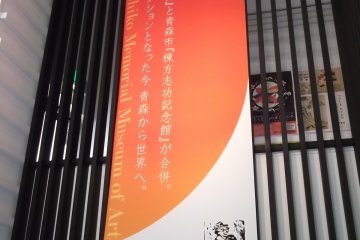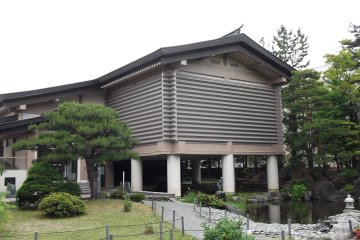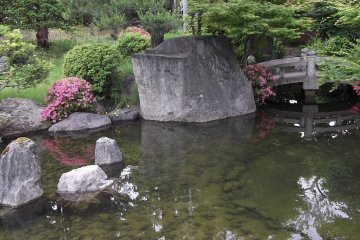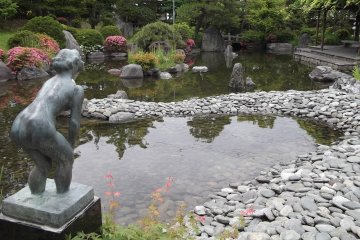Munakata Shiko was an Aomori-born artist best known for his woodblock prints, though he also painted in oils and watercolors. During his career he received a number of international awards, and this museum was opened partly to commemorate his being awarded the Order of Cultural Merit by the Japanese government.
Walking through the gate I came first to a small but beautifully designed tea-garden, complete with a carp pond spanned by an ornamental bridge. This is a nice place to linger for a few moments, to relax and clear your mind before heading inside. In the lobby there’s a looped video being shown about Munakata’s life and work (I assume); it’s only in Japanese, as is all the information in the exhibition rooms, but the staff can provide an English leaflet
There are just two exhibition rooms: the first, smaller one has on permanent display Munakata’s best known work, ‘Ten Great Disciples of Buddha’. There’s an engaging playfulness about these disciples, as some of them are smirking or scowling in distinctly unsaintly fashion, which makes a pleasant change from the humorless reverence of much religious art.
The second room rotates its displays four times a year; when I was there I could see what I suppose was a representative sample of Munakata’s work. At the entrance there was a case holding some of his tools and brushes, and a print laid out next to the block from which it was printed; this was an interesting insight, and made me really appreciate his craftsmanship when I saw some of the other large and highly detailed prints on display.
Some of the prints were a good three or four meters across, and I also saw his ‘Nebuta Festival Scroll’, painted in ink and watercolors with lively festival scenes and calligraphy, twenty-six of my paces from end to end. There were other examples of his colorful, semi-abstract paintings, as well as some couches from which to study and enjoy the art, and a Steinway piano in the center of the room.
There are also a lot of women in his paintings, in a striking diversity of roles and guises: goddesses, embodiments of Buddhist sutras, festival dancers and, in another example of Munakata’s playful humor, as the object of the lecherous gaze of a voyeuristic woodcutter with a striking similarity to his self-portraits.
On your way back out to the garden you might stop off at the small souvenir shop to browse its assortment of cards, prints, stationery and, for anyone planning a large dinner-party, sets of coasters.













